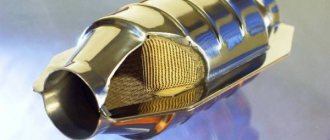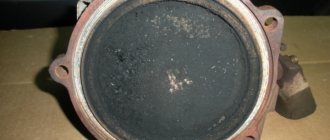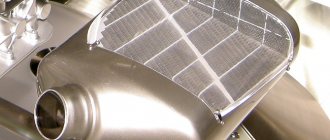Design and principle of operation of the catalytic converter
Car exhaust contains quite a lot of toxic substances. To prevent them from entering the atmosphere, a special device called a “catalytic converter” (better known as a “catalyst”) is used. It is installed on vehicles equipped with internal combustion engines running on both gasoline and diesel fuel. Knowing how a catalyst works will help you understand the importance of its operation and the consequences that removing it can cause.
How to clean the catalyst
There are several ways to clean the catalyst yourself. Depending on how dirty the catalyst is, it is advisable to choose one or another method of cleaning it.
Cleaning the catalyst with sandpaper
If combustion products are not strongly or en masse “stuck” to the catalyst filter element, they can be removed using ordinary sandpaper.
It's quite simple to do this:
- You will need to take fine-grained sandpaper and remove the catalyst;
- Next, carefully, without pressing too hard on the honeycomb, you need to clean off the resulting plaque in a circular motion;
- When the filter element is cleaned, the remaining contaminants are blown out using compressed air.
Important: When cleaning the catalyst with sandpaper, do not overdo it with pressing force. Most often, the “honeycomb” of the catalytic converter is made of ceramic. If you press them too hard, they risk breaking and you will need to buy a new catalyst.
Cleaning heavy catalyst contamination with chemicals
If the catalyst is heavily contaminated, you can use “chemistry” to clean it. In car stores you can find special products for washing and restoring the catalyst. If it is not possible to purchase such a product, carburetor fluid or ethanol will handle the task of cleaning the filter element.
The catalyst should be cleaned with special chemicals in accordance with the instructions. If carburetor fluid is used, the cleaning process is as follows:
- You need to take a plastic container, a bucket in which the catalyst can be placed vertically will do;
- Next, the catalyst is removed from the car and inspected for damage. If they are missing, you can start cleaning, otherwise you will have to think about replacing the filter element;
- The “honeycomb” of the catalyst is generously watered with carburetor cleaning agent, after which the part is wrapped in rags and placed in a plastic container;
Catalyst design and functions
The converter is part of the exhaust system. It is located immediately behind the engine exhaust manifold. The catalyst consists of:
- Metal housing (mounting mat) with inlet and outlet pipes.
- Ceramic block (monolith). It is a porous structure with many cells that increase the area of contact of exhaust gases with the working surface.
- The catalytic layer is a special coating on the surfaces of the cells of a ceramic block, consisting of platinum, palladium and rhodium. The latest models sometimes use gold for sputtering, a precious metal that has a lower cost.
- Metal casing. Performs the functions of thermal insulation and protection of the catalyst from mechanical damage.
The main function of the catalytic converter is to neutralize the three main toxic components of exhaust gases, which is why it got its name - three-component. These are the neutralized components:
- Nitrogen oxides NOx, a component of smog and the cause of acid rain, are toxic to humans.
- Carbon monoxide CO is deadly to humans at concentrations in the air of 0.1%.
- CH hydrocarbons are a component of smog, some compounds are carcinogenic.
Cleaning methods and products used
Car enthusiasts and service station technicians practice 3 methods of cleaning the catalyst from oil deposits and soot:
- Preventive cleaning with detergent is carried out at a mileage of 70–100 thousand km without removal from the car.
- Mechanical cleaning.
- Repeated washing.
The last 2 options involve dismantling and partial disassembling of the neutralizer.
For preventive maintenance of catalysts, special fluids such as Hi-Gear HG3270 are available for sale. The product is simply poured from the bottle into the fuel tank, and then the car is operated as before. The soot removed from the unit flies out along with the exhaust gases.
For mechanical cleaning, you need to have a compressor and prepare fine sandpaper. The method cannot be called successful, since only external contaminants are removed; part of the soot remains deep in the ceramic honeycomb.
Read more: Showmi g800 str firmware
A frequently used chemical for cleaning a removed converter is an ABRO aerosol liquid used for flushing carburetors.
It has been proven by practice that the liquid does not harm the expensive catalytic coating. Sometimes, at their own peril and risk, motorists use kerosene, ethanol and other chemicals, but it is better not to use such folk remedies. It is unknown how they affect an expensive element of a particular car.
Operating principle of the catalyst
In practice, a three-way catalytic converter has the following operating principle:
Exhaust gases from the engine enter the ceramic blocks, where they penetrate the cells, completely filling them.
The catalyst metals palladium and platinum provoke an oxidation reaction, as a result of which unburned hydrocarbons CH are converted into water vapor, and carbon monoxide CO into carbon dioxide.
The reduction metal catalyst rhodium converts NOx (nitrogen oxide) into normal, harmless nitrogen. Purified exhaust gases are released into the atmosphere.
If your car has a diesel engine, there is always a particulate filter near the catalyst. Sometimes these two elements can be combined into a single design. The operating temperature of the catalyst plays a decisive role in the efficiency of the process of neutralizing toxic components. The real transformation begins only after reaching 300°C. The ideal temperature from the point of view of efficiency and service life is from 400 to 800°C. In the temperature range from 800 to 1000°C, accelerated aging of the neutralizer is observed. Prolonged operation at temperatures above 1000°C has a detrimental effect on the catalyst. An alternative to ceramic that can withstand high temperatures is a metal matrix made of corrugated foil. The catalysts in this design are platinum and palladium.
Principle of operation
In chemistry, a catalyst is a substance that accelerates or causes a chemical reaction without being consumed. Such substances are gold, nickel, palladium, copper, rhodium, chromium and most precious and rare metals.
During the operation of a car engine, exhaust gases are generated. These gases enter the exhaust manifold and then into the catalytic converter.
The exhaust gas, consisting of toxic substances, passes through the structure of the converter. Catalyst substances in the converter cause chemical reactions that convert harmful substances into harmless ones.
A modern converter uses two catalysts, namely a reduction catalyst and an oxidation catalyst.
The oxidation catalyst is made of palladium and platinum, and the reduction catalyst is made of rhodium and platinum. As a result of reactions in the catalytic converter, the following are formed: carbon dioxide, nitrogen, water.
What is valuable in catalysts
Unfortunately, there was a lot of valuable stuff there. Noble metals, most suitable for this purpose, had to be used as catalysts.
It got to the point that the cheapest of them turned out to be gold, but more often it is necessary to use platinum, palladium and rhodium. Many people know that these elements are significantly more expensive than gold, which everyone understands.
Simultaneously with the use of such expensive components, it was necessary to create a geometrically complex structure that would ensure contact of the catalytic substance with the entire volume of gas released by the cylinders. These are the smallest ceramic or metal honeycombs through which the entire exhaust flow is blown.
As a result, the car acquired a complex, massive and expensive device in the form of a metal case, high-tech filling, and even framed with control sensors on both sides, continuously monitoring its safety and proper operation.
Eco-friendliness does not come for free. And progress did not stop there; further tightening of legislative requirements continues to influence the emergence of additional exhaust cleaning systems.
How to properly clean a catalyst: a step-by-step guide
As for professional tools like Hi-Gear, all you need to do is pour the contents of the cylinder into the gas tank. Then the chemicals will do everything themselves, you don’t need to interfere with the process. But how to wash the catalyst if it is not possible to use such products?
First of all, you need to disconnect the oxygen sensors and loosen the clamps that hold the catalyst. Then perform a few manipulations:
- At the first step, you will need a compressor capable of pumping up about 9 bar of pressure. You need to thoroughly blow out the neutralizer on both sides.
- Using fine sandpaper, carefully sand the outer surfaces of the honeycomb.
- Fill the honeycomb with carburetor cleaning foam.
- Wrap the unit in a rag and wait 15-20 minutes.
- Turn on the hot water and wash all the insides, after which you will need to dry everything with a compressor.
- If necessary, the manipulations are repeated several times until all cells are viewed.
We looked at how to wash the catalyst with your own hands. But it is quite possible that the dirt cannot be cleaned; the aerosol for carburetors does not work. Therefore, it is permissible to resort to extreme measures. To do this, dilute kerosene with solvent 646 or acetone (in a ratio of 4 to 1). Immerse the catalyst in this composition for about a day, then repeat cleaning with air and aerosol.
Read US on VKontakte
In diesel
Catalysts in a diesel engine perform much worse at reducing NOx emissions. One reason for this is that diesel engines have lower operating temperatures than gasoline engines, and the catalyst in general in a diesel engine does not work as well because it runs less hot. Some of the leading eco-auto experts have come up with a new system that helps combat this. They use urea to solve this problem: before the nitrogen oxides go into the catalyst, they are forced to evaporate and mix with the exhaust and then create a chemical reaction that will lead to a reduction in NOx emissions. Urea, also known as urea, is an organic compound made from carbon, nitrogen, oxygen and hydrogen. Urea is found in the urine of mammals and amphibians. Urea reacts with NOx, producing nitrogen and water vapor in the reaction and disposing of more than 90 percent of the nitrogen oxides in exhaust gases.
Types of catalysts
According to its purpose, the neutralizer can be two- or three-component.
- In the first case, it performs the relatively simple functions of oxidizing (afterburning) carbon monoxide and hydrocarbons to form water and carbon dioxide.
- In the second, the device’s sophisticated ability to work with nitrogen oxides is added. Especially a lot of them are formed in modern diesel and gasoline engines, due to increased efficiency, the designers of which have to use lean and lean mixtures at the inlet.
Three-component catalysts, namely the ones most often used, in turn, can differ in design, being made on the basis of ceramic or metal honeycomb products.
Ceramic ones are relatively cheaper, but do not have high mechanical strength and durability, are prone to cracking and destruction, and do not withstand impacts when hitting obstacles.
Metal structures have sufficient elasticity, so they better withstand external and internal impacts. Internal ones can occur during abnormal combustion processes and have a destructive effect on the thin honeycomb filling, where, as already mentioned, such complex substances as platinum, palladium and rhodium are usually applied.
But even metal does not save you from the treacherous ingress of foreign substances from the engine into the thin honeycombs in the form of components of counterfeit working fluids, too rich a mixture or all kinds of silicon compounds.
Catalysts also differ in the way they are installed. Previously, they were located in the form of exhaust pipe inserts, like mufflers and resonators. But it turned out that it is very difficult and expensive to warm them up to the operating temperature at which catalytic reactions begin.
Therefore, now neutralizers are installed directly behind the exhaust manifold, as close as possible to the exit point of hot exhaust gases. You no longer have to wait long for the device to return to operating mode, oxygen sensors become less dirty and fuel consumption for maintaining temperature is reduced.
Catalyst repair: the essence of the service
This is a rather complex element of the car, so its repair consists of a simple replacement. Initially, the catalyst, clogged with combustion waste, is cut out, after which a new device is installed. There are three ways to carry out such work:
- Installation of original equipment from the manufacturer. This method is relatively expensive, but it provides maximum quality.
- Repair of mufflers and catalysts by installing a universal model of this equipment. This method is considered the most acceptable. Our specialists use universal catalysts from manufacturers such as Bosal, Asso, Walker, Fenno and JP.
- Replacing the catalyst with a flame arrester. To do this, you will need to cut out the catalyst, remove its honeycomb structure and convert it into a resonator. This method is relatively inexpensive. However, flame arresters are not capable of maximally neutralizing the toxicity of exhaust.
Catalyst life
The average service life of a catalyst is 100 thousand kilometers, but with proper operation it can function properly for up to 200 thousand kilometers. The main reasons for early wear are engine malfunction and fuel quality (fuel-air mixture). If the mixture is lean, overheating occurs, and if it is too rich, the porous block becomes clogged with remnants of unburned fuel, which prevents the necessary chemical processes from occurring. This leads to the fact that the service life of the catalytic converter is significantly reduced. Another common cause of failure of a ceramic catalyst is mechanical damage (cracks) that occurs due to mechanical stress. They provoke rapid destruction of blocks. If a malfunction occurs, the performance of the catalytic converter deteriorates, which is detected using a second lambda probe. In this case, the electronic control unit will report a malfunction by displaying the “CHECK ENGINE” error on the dashboard. Also signs of failure are rattling, increased fuel consumption and deterioration in dynamics. In this case, it is replaced with a new one (original production or universal). It is impossible to clean or restore catalysts, and since this device is expensive, many motorists prefer to simply remove it.
Methods and means for cleaning
Today, there are several options for cleaning the catalyst from soot and deposits. The main ones are:
- Cleaning for preventive purposes using cleaning agents is carried out after a mileage of 70,000 to 100,000 km without prior removal from the vehicle.
- Mechanical cleaning.
- Thorough rinsing.
It will be useful: Which wheels are better to put winter tires on?
In the last two cases, removal and incomplete disassembly of the catalyst is assumed. For prevention, you can purchase special formulations. For example, Hi-Gear HG 3270 is especially popular among motorists. The mixture is simply poured into the fuel tank, after which the vehicle can continue to be used as usual.
Mechanical cleaning is performed using fine sandpaper and a compressor. This technique is not particularly effective, since it only removes contamination from the outside, that is, carbon deposits and soot will remain in the honeycombs.
Experts from car service centers advise using ABRO liquid to clean a disassembled catalyst. Despite the fact that it is used to service carburetors, it can also be very useful for the converter. Hobbyists sometimes try to wash the catalyst on their car using ethanol, kerosene and other chemicals. But it is better not to experiment with such substances.
Is it possible to remove the catalyst?
When the catalyst is removed, it is often replaced with a flame arrester. The latter evens out the flow of exhaust gases. Its installation is recommended to eliminate the unpleasant noise that occurs when removing the catalyst. At the same time, if you choose removal, it is better to completely remove the device and not resort to the recommendations of some motorists to punch a hole in it. Such a procedure will improve the situation only temporarily. In cars that meet Euro-3 environmental standards, in addition to removing the catalyst, it is necessary to flash the electronic control unit. It is being updated to a version that does not have a catalytic converter. You can also install an oxygen sensor signal emulator, which will eliminate the need to reflash the ECU.
What is a catalyst, its types
At its core, a catalyst is a filter that cleans exhaust as it passes through the system. We carry out all possible types of muffler repairs, as well as catalyst removal in Moscow. Do you need to cut out the catalyst from a foreign car? No problem! The company services cars of such brands as: Acura, Audi, BMW, Chevrolet, Chrysler, Dodge, Ford, Honda, Hyundai, Infiniti, Jeep, Kia, Land Rover, Lexus, Mazda, Mercedes, Mitsubishi, Nissan, Opel, Peugeot, Porshe , Renault, Skoda, Subaru, Suzuki, Toyota, Volkswagen, Volvo.
In addition, installation and removal of catalysts is possible on other models not included in this list.
| Name of works: | Price: |
| Diagnostics and troubleshooting of the exhaust system | for free |
| Replacing the catalyst (part + labor) | from 5000 rub. |
| Installing a mini-catalyst (lambda probe emulator) | from 1000 rub. |
Our price list










